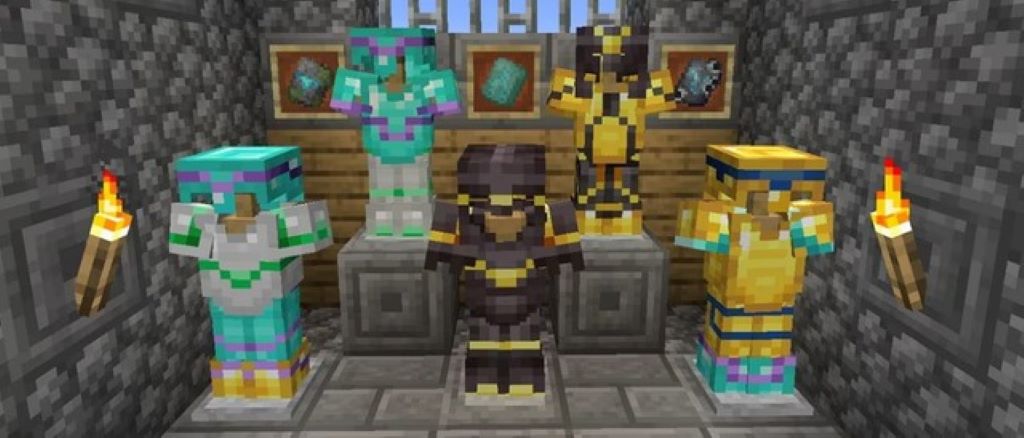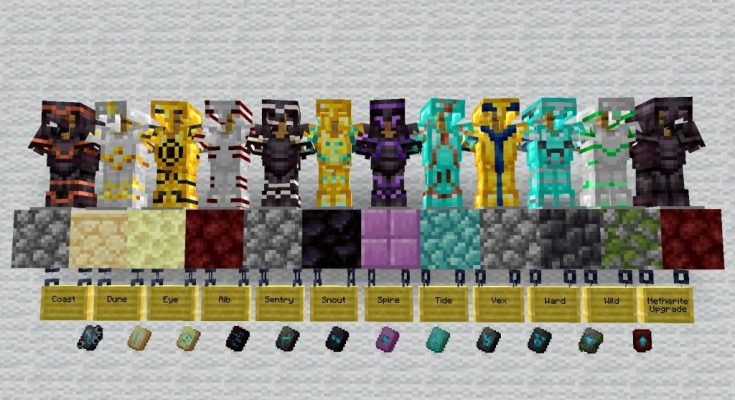Imagine stepping into the vast, blocky world of Minecraft, your diamond armor gleaming under the sun, but with a twist—intricate patterns and vibrant colors that make your gear stand out in a multiplayer server or showcase your adventures in style. That’s the magic of Minecraft armor trims, a feature introduced in the 1.20 Trails and Tales update that lets players personalize their armor like never before. Whether you’re a seasoned explorer or a casual builder, armor trims offer a way to express your creativity without sacrificing protection. In this comprehensive guide, we’ll dive into everything you need to know about armor trims: what they are, how to find them, how to apply them, and tips to make your armor the envy of every player. Let’s craft some style!
What Are Minecraft Armor Trims?
Armor trims are purely cosmetic enhancements that allow you to add unique patterns to your armor using smithing templates and various materials. Introduced in Minecraft 1.20, they don’t affect armor stats but provide a visual flair that reflects your in-game achievements or personal taste. Each trim is tied to a specific biome or structure, making the hunt for these templates an adventure in itself. With 18 unique armor trims available as of the 1.21.4 Tricky Trials update, and the ability to pair them with 11 different materials, the customization possibilities are nearly endless—over 100,000 combinations for a full armor set!
The appeal of armor trims lies in their ability to tell a story. A Silence trim from an Ancient City screams bravery in the Deep Dark, while a Coast trim from a Shipwreck hints at oceanic adventures. Whether you’re aiming for a sleek, modern look or a rugged, battle-worn aesthetic, armor trims let you craft a signature style.
Why Use Armor Trims?
Beyond looking cool, armor trims serve practical purposes in Minecraft’s vast world:
- Personalization: Stand out on multiplayer servers by customizing your armor to match your skin or personality.
- Organization: Differentiate armor sets with unique trims to quickly identify enchanted or specialized gear.
- Bragging Rights: Rare trims like Silence (1.2% drop rate in Ancient Cities) showcase your exploration skills.
- Aesthetic Display: Use trimmed armor on armor stands to decorate your Minecraft base with flair.
With no impact on gameplay mechanics, trims are all about creativity and self-expression, making them a perfect addition for players who love to build, explore, or socialize.
How to Find Armor Trim Smithing Templates
Finding smithing templates is the first step to unlocking armor trims. Each of the 18 templates is tied to a specific structure or mob, and some are rarer than others. Below is a complete list of armor trims, their locations, and their drop rates to help you plan your adventure:
- Sentry Armor Trim: Found in Pillager Outpost chests (25% chance, 2 templates).
- Vex Armor Trim: Woodland Mansion chests (50% chance, 1 template).
- Wild Armor Trim: Jungle Temple chests (33.3% chance, 2 templates).
- Coast Armor Trim: Shipwreck treasure, supply, or map chests (16.7% chance, 2 templates).
- Dune Armor Trim: Desert Pyramid chests (14.3% chance, 2 templates).
- Ward Armor Trim: Ancient City chests (5% chance, 1 template).
- Silence Armor Trim: Ancient City chests (1.2% chance, 1 template, the rarest trim).
- Snout Armor Trim: Bastion Remnant chests (8.3% chance, 1 template).
- Rib Armor Trim: Nether Fortress chests (6.7% chance, 1 template).
- Eye Armor Trim: Stronghold altar (10%) or library chests (100%, 1 template).
- Spire Armor Trim: End City chests (6.7% chance, 1 template).
- Tide Armor Trim: Dropped by Elder Guardians in Ocean Monuments (20% chance, 1 template).
- Wayfinder Armor Trim: Trail Ruins suspicious gravel (8.3% chance, 1 template).
- Raiser Armor Trim: Trail Ruins suspicious gravel (8.3% chance, 1 template).
- Shaper Armor Trim: Trail Ruins suspicious gravel (8.3% chance, 1 template).
- Host Armor Trim: Trail Ruins suspicious gravel (8.3% chance, 1 template).
- Flow Armor Trim: Trial Chambers ominous vaults (22.5% chance, 1 template).
- Bolt Armor Trim: Trial Chambers regular vaults (6.3% chance, 1 template).
Tips for Finding Smithing Templates
- Use /locate: If cheats are enabled, use commands like /locate structure pillager_outpost to find structures quickly.
- Looting Enchantment: Equip a Looting III sword to boost chest loot chances (doesn’t affect Elder Guardian drops).
- Exploration Tools: For structures like Ancient Cities, bring Swift Sneak leggings and wool to avoid triggering the Warden. For Shipwrecks, use Potions of Water Breathing or a Respiration helmet.
- Cartographer Maps: Trade with a Cartographer villager for a Woodland Explorer Map to locate Woodland Mansions.

How to Apply Armor Trims
Once you’ve collected a smithing template, applying a trim is straightforward but requires specific materials and a Smithing Table. Here’s the step-by-step process:
- Craft or Find a Smithing Table: Combine 2 iron ingots and 4 wooden planks in a crafting table.
- Open the Smithing Table UI: Interact with the table to access its interface, which now includes a slot for smithing templates.
- Add Your Materials:
- Slot 1: Place the smithing template (e.g., Sentry, Vex, etc.).
- Slot 2: Place the armor piece (helmet, chestplate, leggings, or boots; any material—leather, iron, diamond, etc.).
- Slot 3: Add a color material (choose from 11 options to determine the trim’s color).
- Collect Your Trimmed Armor: The customized armor appears in the output slot. The template and materials are consumed in the process.
Color Materials for Armor Trims
The material you choose determines the trim’s color, adding another layer of customization. Here’s the full list:
- Amethyst: Purple
- Copper: Copper-orange
- Diamond: Cyan
- Emerald: Green
- Gold: Gold
- Iron: Silver
- Lapis Lazuli: Blue
- Netherite: Slate
- Redstone: Red
- Quartz: White
- Resin: Orange (introduced in 1.21)
Pro Tip: Avoid matching the trim material to the armor material (e.g., diamond trim on diamond armor) for better visual contrast. For example, a gold trim on netherite armor creates a striking regal look.
Duplicating Smithing Templates
Smithing templates are consumed upon use, but you can duplicate them to avoid repeated treasure hunts. To duplicate a template:
- Crafting Table: Combine 7 diamonds, the smithing template, and a specific base material tied to the trim’s origin.
- Base Materials:
- Sentry, Vex, Coast: Cobblestone
- Wild: Mossy Cobblestone
- Dune: Sandstone
- Tide: Prismarine
- Snout: Blackstone
- Rib, Netherite Upgrade: Netherrack
- Eye: End Stone
- Spire: Purpur Block
- Ward, Silence: Cobbled Deepslate
- Wayfinder, Raiser, Shaper, Host: Terracotta
- Flow: Breeze Rod
- Bolt: Copper Block
This process is costly but saves time, especially for rare trims like Silence. Stock up on diamonds before duplicating!
Best Armor Trims for Style
With 18 trims to choose from, some stand out for their unique designs. Here are five fan-favorite trims and why they’re loved:
- Silence Trim: Its intricate sculk-inspired patterns and rarity make it a status symbol. Pair with amethyst for a mystical purple glow.
- Vex Trim: Evoker-inspired with eerie eyes on the helmet, perfect for a dark, magical aesthetic. Try it with lapis for a vibrant blue.
- Coast Trim: Clean, sleek lines inspired by the ocean. Looks stunning with quartz for a crisp white trim.
- Rib Trim: Skeleton-like horizontal lines give a gritty, battle-worn vibe. Pair with netherite for a menacing look.
- Eye Trim: Bold eye-like patterns on the helmet and chestplate create an intimidating effect. Gold or emerald enhances its pop.
Experiment with different armor types (leather, chainmail, iron, diamond, netherite, or copper) and colors to find your perfect combo. For example, a Wild trim with emerald on leather armor screams jungle explorer.
Troubleshooting Common Issues
- Can’t Find Templates? Use /locate commands or trade for explorer maps. Ensure you’re looting the correct chest type (e.g., library chests for Eye trim).
- Running Out of Templates? Prioritize duplicating rare trims like Silence or Ward to save exploration time.
- Trim Not Showing? Ensure you’re using a compatible material and that the armor isn’t already trimmed (you can’t re-trim armor).
Conclusion and Call to Action
Minecraft armor trims are more than just a cosmetic upgrade—they’re a way to showcase your journey, creativity, and style in the blocky universe. From braving Ancient Cities for the elusive Silence trim to sailing oceans for the Coast trim, the hunt for smithing templates is an adventure that rewards exploration and persistence. With endless combinations of trims, armor types, and colors, you can craft a look that’s uniquely yours.
Related Topics:
Hemorrhoids in Children: Causes, Symptoms, Treatment
Simple and Fun Birthday Venue Ideas for Your Child’s Next Birthday Bash



